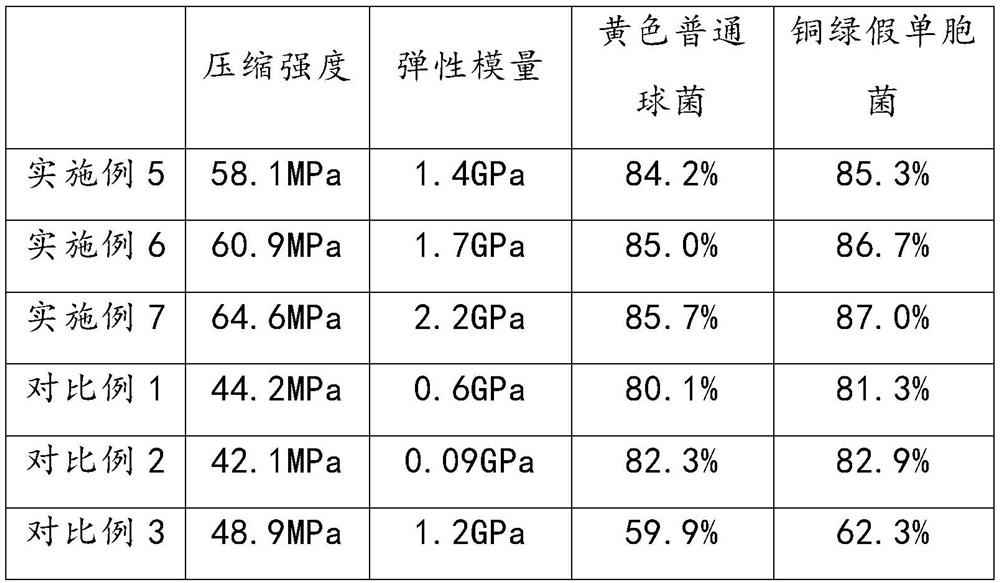Bone repair material for large-volume defect of mandible
A large-volume, mandibular technology, applied in the direction of prosthesis, drug delivery, tissue regeneration, etc., can solve the problems of poor formability, poor scaffold strength, and failure to meet the mechanical performance requirements of mandibular bone repair material scaffolds, etc., to achieve excellent strength and toughness, improving elastic strength and wear resistance, excellent biocompatibility and degradation rate
- Summary
- Abstract
- Description
- Claims
- Application Information
AI Technical Summary
Problems solved by technology
Method used
Image
Examples
Embodiment 1
[0027] Preparation of chloropropyl-POSS:
[0028] Add methanol into a three-necked flask with a thermometer and a stirring device, add (3-chloropropyl)trimethoxysilane under stirring, continue to stir to make them fully mixed, then add concentrated hydrochloric acid, after fully stirring, slowly heat up to 40 ℃, 1000r / min stirring reaction for 10d, so that the hydrolysis rearrangement reaction fully proceeds, after the reaction, filter, take the precipitate and wash it several times with methanol, then vacuum dry to obtain chloropropyl-POSS, wherein (3-chloropropyl ) The ratio of trimethoxysilane, methanol and concentrated hydrochloric acid is 0.05-0.065mol: 260-270mL: 8-9mL.
Embodiment 2
[0030] Preparation of zinc silicate powder:
[0031] While stirring, add ethyl orthosilicate to the zinc acetate solution, and after stirring for 20-40 minutes, add ammonia solution drop by drop to adjust the pH value of the mixed solution to 7±0.4, continue stirring for 5 minutes, and then transfer the mixed solution to In a hydrothermal reaction vessel, react at 170°C for 4 hours, cool, centrifuge, remove precipitation, and dry to obtain zinc silicate powder, wherein the molar ratio of zinc to silicon is controlled at 2:1, and the concentration of zinc acetate solution is 5wt% .
Embodiment 3
[0033] Preparation of POSS grafted polycaprolactone:
[0034] Step A. Add the chloropropyl-POSS, hexamethylenediamine, methylhydroquinone and triethylamine prepared in Example 1 into a three-necked flask equipped with a condensing device and a stirring device, stir evenly, and heat the ester at 65°C for 5 hours. Cool to room temperature and filter to obtain grafted POSS, wherein the molar ratio of chloropropyl-POSS, hexamethylenediamine, and triethylamine is 1:2.5:2, and the mass of methylhydroquinone added is the mass of chloropropyl-POSS 0.05% of;
[0035] Step B: Add grafted POSS and caprolactone into a three-necked flask, under nitrogen atmosphere, at 120°C, add stannous octoate, stir for 24 hours, cool down to room temperature, add dichloromethane, stir evenly, then add propanol for precipitation, Filtration, precipitation washed with dichloromethane, centrifugation, repeated 3 times, vacuum-dried to obtain POSS grafted polycaprolactone, wherein, the amount ratio of grafte...
PUM
| Property | Measurement | Unit |
|---|---|---|
| concentration | aaaaa | aaaaa |
Abstract
Description
Claims
Application Information
 Login to View More
Login to View More - R&D
- Intellectual Property
- Life Sciences
- Materials
- Tech Scout
- Unparalleled Data Quality
- Higher Quality Content
- 60% Fewer Hallucinations
Browse by: Latest US Patents, China's latest patents, Technical Efficacy Thesaurus, Application Domain, Technology Topic, Popular Technical Reports.
© 2025 PatSnap. All rights reserved.Legal|Privacy policy|Modern Slavery Act Transparency Statement|Sitemap|About US| Contact US: help@patsnap.com

